Strategic Management and Planning for Bentley Motors
VerifiedAdded on 2023/06/14
|14
|3545
|312
AI Summary
The report focuses on the strategic management and planning for Bentley Motors. It includes competitor analysis, PESTEL analysis, Porter's Five Forces model, and McKinsey 7s framework methods of environmental analysis. The report also identifies the strengths, weakness as well as the opportunities and threats that exist in the environment.
Contribute Materials
Your contribution can guide someone’s learning journey. Share your
documents today.

Student name:
Registration number:
Unit Code:
Unit Title:
Name of supervisor:
Date due:
Registration number:
Unit Code:
Unit Title:
Name of supervisor:
Date due:
Secure Best Marks with AI Grader
Need help grading? Try our AI Grader for instant feedback on your assignments.
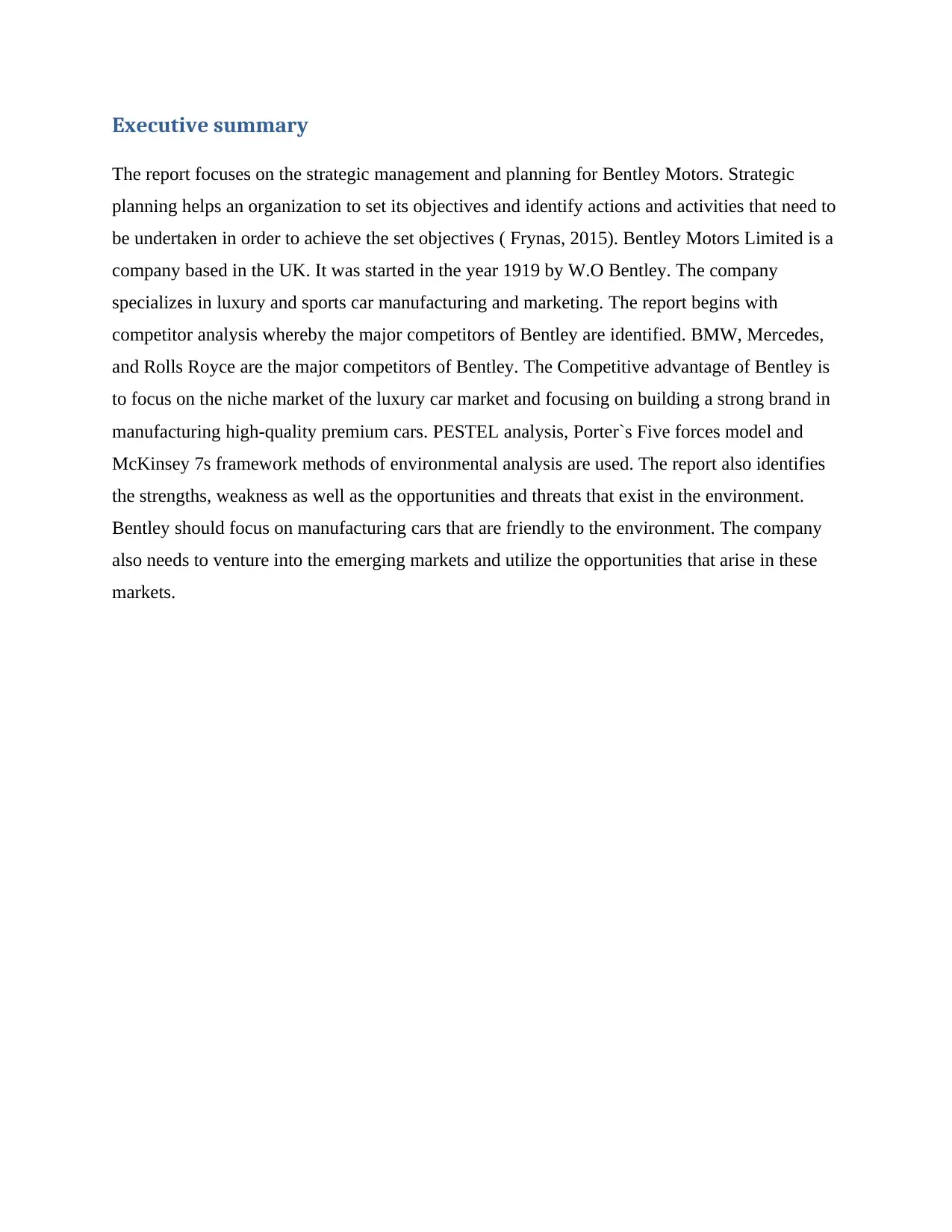
Executive summary
The report focuses on the strategic management and planning for Bentley Motors. Strategic
planning helps an organization to set its objectives and identify actions and activities that need to
be undertaken in order to achieve the set objectives ( Frynas, 2015). Bentley Motors Limited is a
company based in the UK. It was started in the year 1919 by W.O Bentley. The company
specializes in luxury and sports car manufacturing and marketing. The report begins with
competitor analysis whereby the major competitors of Bentley are identified. BMW, Mercedes,
and Rolls Royce are the major competitors of Bentley. The Competitive advantage of Bentley is
to focus on the niche market of the luxury car market and focusing on building a strong brand in
manufacturing high-quality premium cars. PESTEL analysis, Porter`s Five forces model and
McKinsey 7s framework methods of environmental analysis are used. The report also identifies
the strengths, weakness as well as the opportunities and threats that exist in the environment.
Bentley should focus on manufacturing cars that are friendly to the environment. The company
also needs to venture into the emerging markets and utilize the opportunities that arise in these
markets.
The report focuses on the strategic management and planning for Bentley Motors. Strategic
planning helps an organization to set its objectives and identify actions and activities that need to
be undertaken in order to achieve the set objectives ( Frynas, 2015). Bentley Motors Limited is a
company based in the UK. It was started in the year 1919 by W.O Bentley. The company
specializes in luxury and sports car manufacturing and marketing. The report begins with
competitor analysis whereby the major competitors of Bentley are identified. BMW, Mercedes,
and Rolls Royce are the major competitors of Bentley. The Competitive advantage of Bentley is
to focus on the niche market of the luxury car market and focusing on building a strong brand in
manufacturing high-quality premium cars. PESTEL analysis, Porter`s Five forces model and
McKinsey 7s framework methods of environmental analysis are used. The report also identifies
the strengths, weakness as well as the opportunities and threats that exist in the environment.
Bentley should focus on manufacturing cars that are friendly to the environment. The company
also needs to venture into the emerging markets and utilize the opportunities that arise in these
markets.
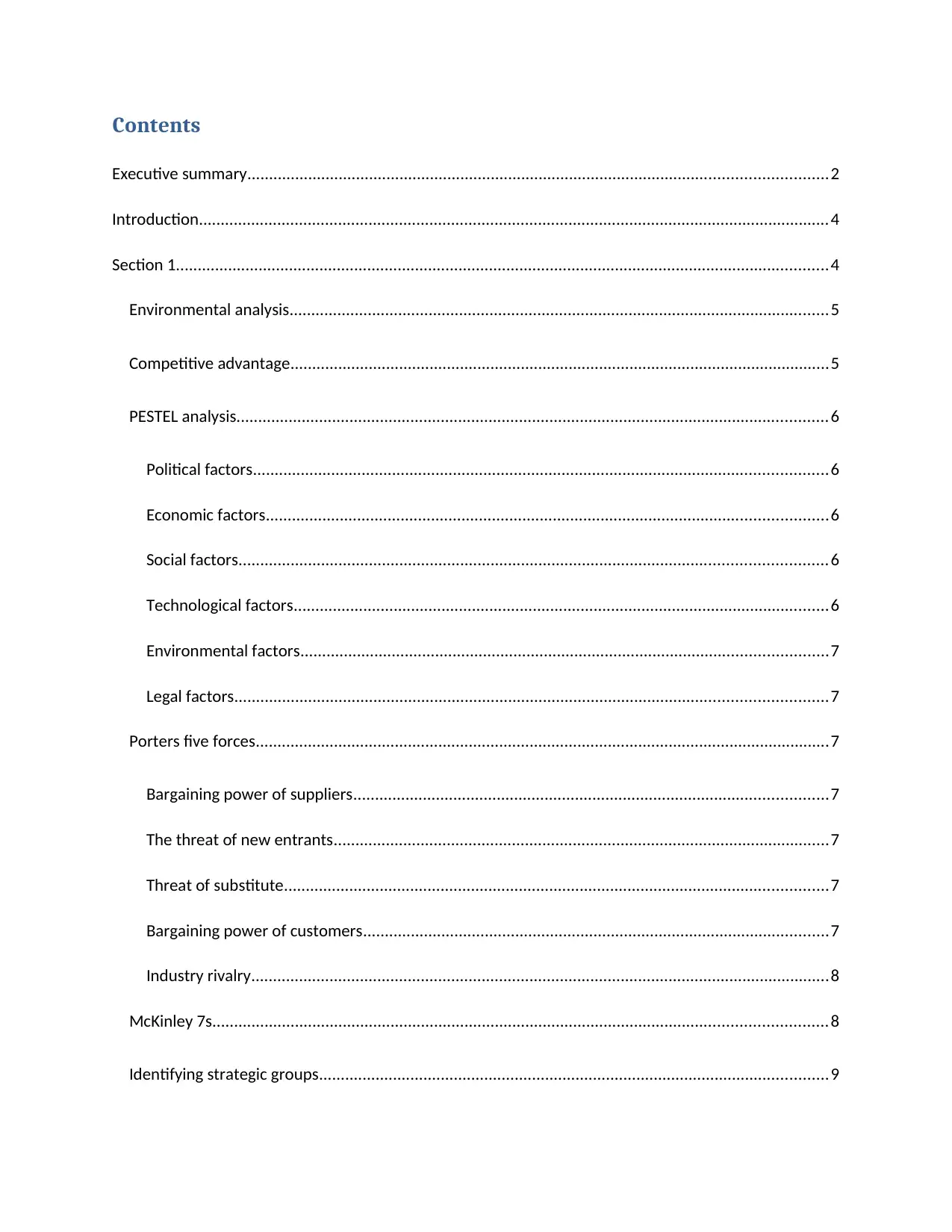
Contents
Executive summary.....................................................................................................................................2
Introduction.................................................................................................................................................4
Section 1......................................................................................................................................................4
Environmental analysis............................................................................................................................5
Competitive advantage............................................................................................................................5
PESTEL analysis........................................................................................................................................6
Political factors....................................................................................................................................6
Economic factors.................................................................................................................................6
Social factors.......................................................................................................................................6
Technological factors...........................................................................................................................6
Environmental factors.........................................................................................................................7
Legal factors........................................................................................................................................7
Porters five forces....................................................................................................................................7
Bargaining power of suppliers.............................................................................................................7
The threat of new entrants..................................................................................................................7
Threat of substitute.............................................................................................................................7
Bargaining power of customers...........................................................................................................7
Industry rivalry.....................................................................................................................................8
McKinley 7s.............................................................................................................................................8
Identifying strategic groups.....................................................................................................................9
Executive summary.....................................................................................................................................2
Introduction.................................................................................................................................................4
Section 1......................................................................................................................................................4
Environmental analysis............................................................................................................................5
Competitive advantage............................................................................................................................5
PESTEL analysis........................................................................................................................................6
Political factors....................................................................................................................................6
Economic factors.................................................................................................................................6
Social factors.......................................................................................................................................6
Technological factors...........................................................................................................................6
Environmental factors.........................................................................................................................7
Legal factors........................................................................................................................................7
Porters five forces....................................................................................................................................7
Bargaining power of suppliers.............................................................................................................7
The threat of new entrants..................................................................................................................7
Threat of substitute.............................................................................................................................7
Bargaining power of customers...........................................................................................................7
Industry rivalry.....................................................................................................................................8
McKinley 7s.............................................................................................................................................8
Identifying strategic groups.....................................................................................................................9

Section Two.................................................................................................................................................9
Strengths.................................................................................................................................................9
Weaknesses...........................................................................................................................................10
Opportunities........................................................................................................................................10
Threats...................................................................................................................................................10
Section Three.............................................................................................................................................11
Recommended action plan....................................................................................................................11
Conclusion.................................................................................................................................................11
References.................................................................................................................................................12
Strengths.................................................................................................................................................9
Weaknesses...........................................................................................................................................10
Opportunities........................................................................................................................................10
Threats...................................................................................................................................................10
Section Three.............................................................................................................................................11
Recommended action plan....................................................................................................................11
Conclusion.................................................................................................................................................11
References.................................................................................................................................................12
Secure Best Marks with AI Grader
Need help grading? Try our AI Grader for instant feedback on your assignments.
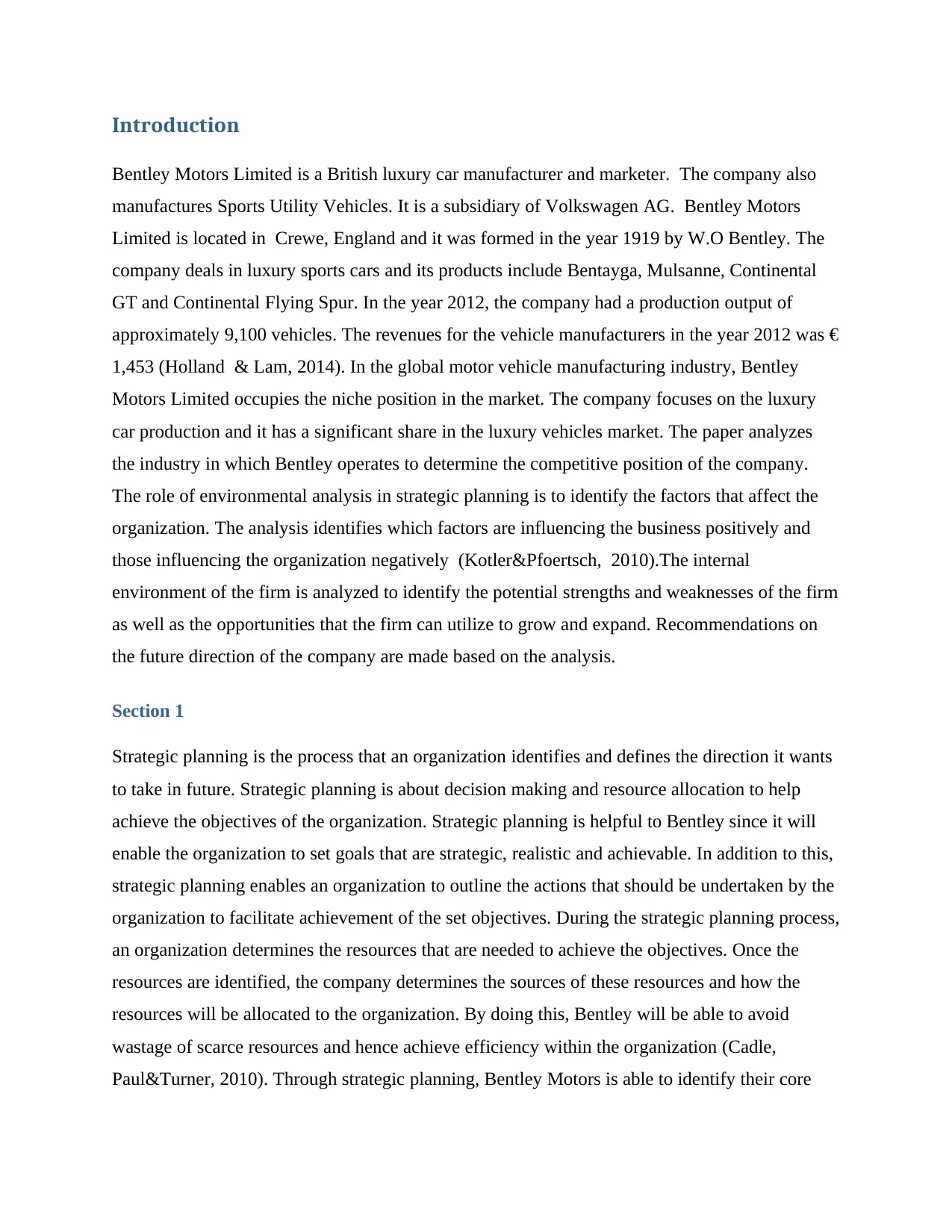
Introduction
Bentley Motors Limited is a British luxury car manufacturer and marketer. The company also
manufactures Sports Utility Vehicles. It is a subsidiary of Volkswagen AG. Bentley Motors
Limited is located in Crewe, England and it was formed in the year 1919 by W.O Bentley. The
company deals in luxury sports cars and its products include Bentayga, Mulsanne, Continental
GT and Continental Flying Spur. In the year 2012, the company had a production output of
approximately 9,100 vehicles. The revenues for the vehicle manufacturers in the year 2012 was €
1,453 (Holland & Lam, 2014). In the global motor vehicle manufacturing industry, Bentley
Motors Limited occupies the niche position in the market. The company focuses on the luxury
car production and it has a significant share in the luxury vehicles market. The paper analyzes
the industry in which Bentley operates to determine the competitive position of the company.
The role of environmental analysis in strategic planning is to identify the factors that affect the
organization. The analysis identifies which factors are influencing the business positively and
those influencing the organization negatively (Kotler&Pfoertsch, 2010).The internal
environment of the firm is analyzed to identify the potential strengths and weaknesses of the firm
as well as the opportunities that the firm can utilize to grow and expand. Recommendations on
the future direction of the company are made based on the analysis.
Section 1
Strategic planning is the process that an organization identifies and defines the direction it wants
to take in future. Strategic planning is about decision making and resource allocation to help
achieve the objectives of the organization. Strategic planning is helpful to Bentley since it will
enable the organization to set goals that are strategic, realistic and achievable. In addition to this,
strategic planning enables an organization to outline the actions that should be undertaken by the
organization to facilitate achievement of the set objectives. During the strategic planning process,
an organization determines the resources that are needed to achieve the objectives. Once the
resources are identified, the company determines the sources of these resources and how the
resources will be allocated to the organization. By doing this, Bentley will be able to avoid
wastage of scarce resources and hence achieve efficiency within the organization (Cadle,
Paul&Turner, 2010). Through strategic planning, Bentley Motors is able to identify their core
Bentley Motors Limited is a British luxury car manufacturer and marketer. The company also
manufactures Sports Utility Vehicles. It is a subsidiary of Volkswagen AG. Bentley Motors
Limited is located in Crewe, England and it was formed in the year 1919 by W.O Bentley. The
company deals in luxury sports cars and its products include Bentayga, Mulsanne, Continental
GT and Continental Flying Spur. In the year 2012, the company had a production output of
approximately 9,100 vehicles. The revenues for the vehicle manufacturers in the year 2012 was €
1,453 (Holland & Lam, 2014). In the global motor vehicle manufacturing industry, Bentley
Motors Limited occupies the niche position in the market. The company focuses on the luxury
car production and it has a significant share in the luxury vehicles market. The paper analyzes
the industry in which Bentley operates to determine the competitive position of the company.
The role of environmental analysis in strategic planning is to identify the factors that affect the
organization. The analysis identifies which factors are influencing the business positively and
those influencing the organization negatively (Kotler&Pfoertsch, 2010).The internal
environment of the firm is analyzed to identify the potential strengths and weaknesses of the firm
as well as the opportunities that the firm can utilize to grow and expand. Recommendations on
the future direction of the company are made based on the analysis.
Section 1
Strategic planning is the process that an organization identifies and defines the direction it wants
to take in future. Strategic planning is about decision making and resource allocation to help
achieve the objectives of the organization. Strategic planning is helpful to Bentley since it will
enable the organization to set goals that are strategic, realistic and achievable. In addition to this,
strategic planning enables an organization to outline the actions that should be undertaken by the
organization to facilitate achievement of the set objectives. During the strategic planning process,
an organization determines the resources that are needed to achieve the objectives. Once the
resources are identified, the company determines the sources of these resources and how the
resources will be allocated to the organization. By doing this, Bentley will be able to avoid
wastage of scarce resources and hence achieve efficiency within the organization (Cadle,
Paul&Turner, 2010). Through strategic planning, Bentley Motors is able to identify their core
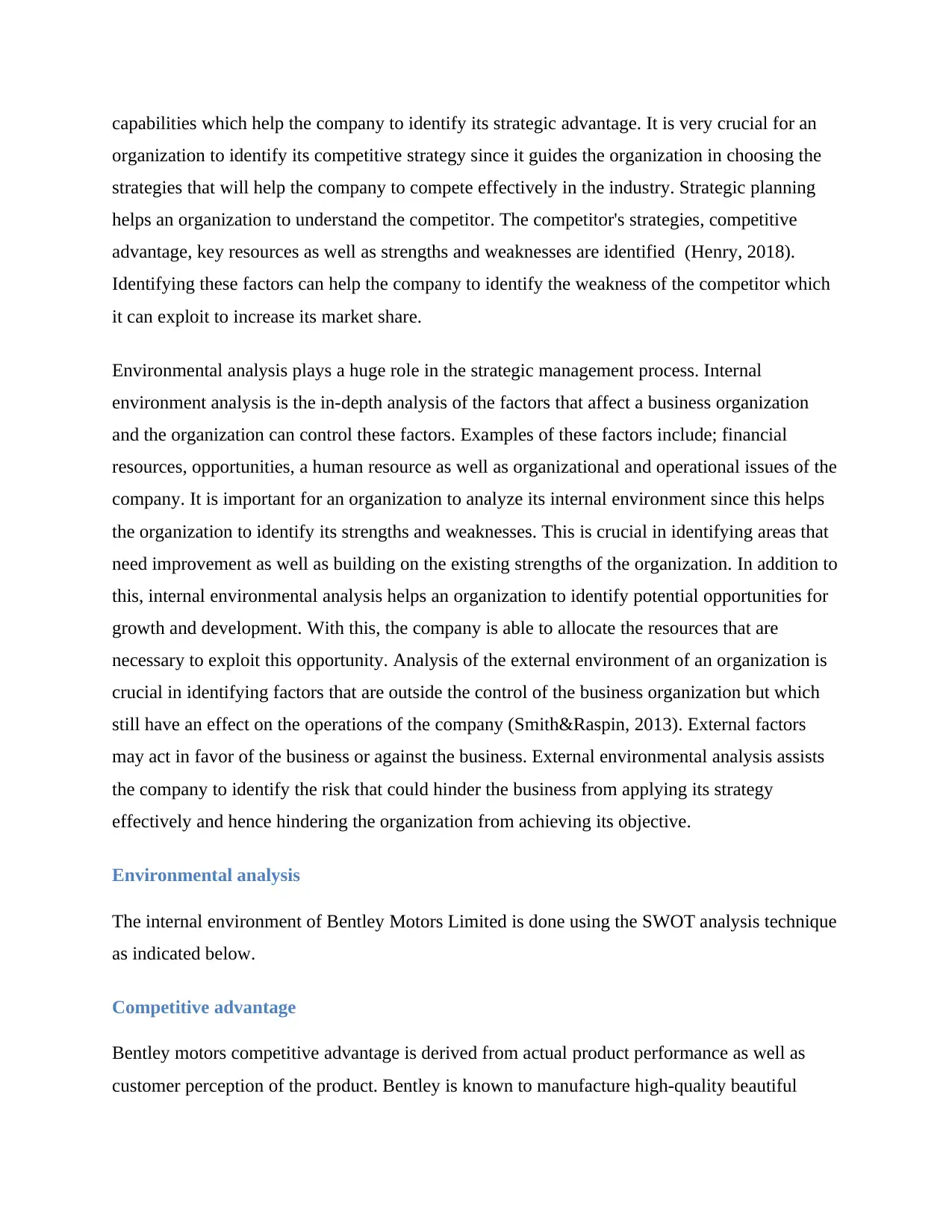
capabilities which help the company to identify its strategic advantage. It is very crucial for an
organization to identify its competitive strategy since it guides the organization in choosing the
strategies that will help the company to compete effectively in the industry. Strategic planning
helps an organization to understand the competitor. The competitor's strategies, competitive
advantage, key resources as well as strengths and weaknesses are identified (Henry, 2018).
Identifying these factors can help the company to identify the weakness of the competitor which
it can exploit to increase its market share.
Environmental analysis plays a huge role in the strategic management process. Internal
environment analysis is the in-depth analysis of the factors that affect a business organization
and the organization can control these factors. Examples of these factors include; financial
resources, opportunities, a human resource as well as organizational and operational issues of the
company. It is important for an organization to analyze its internal environment since this helps
the organization to identify its strengths and weaknesses. This is crucial in identifying areas that
need improvement as well as building on the existing strengths of the organization. In addition to
this, internal environmental analysis helps an organization to identify potential opportunities for
growth and development. With this, the company is able to allocate the resources that are
necessary to exploit this opportunity. Analysis of the external environment of an organization is
crucial in identifying factors that are outside the control of the business organization but which
still have an effect on the operations of the company (Smith&Raspin, 2013). External factors
may act in favor of the business or against the business. External environmental analysis assists
the company to identify the risk that could hinder the business from applying its strategy
effectively and hence hindering the organization from achieving its objective.
Environmental analysis
The internal environment of Bentley Motors Limited is done using the SWOT analysis technique
as indicated below.
Competitive advantage
Bentley motors competitive advantage is derived from actual product performance as well as
customer perception of the product. Bentley is known to manufacture high-quality beautiful
organization to identify its competitive strategy since it guides the organization in choosing the
strategies that will help the company to compete effectively in the industry. Strategic planning
helps an organization to understand the competitor. The competitor's strategies, competitive
advantage, key resources as well as strengths and weaknesses are identified (Henry, 2018).
Identifying these factors can help the company to identify the weakness of the competitor which
it can exploit to increase its market share.
Environmental analysis plays a huge role in the strategic management process. Internal
environment analysis is the in-depth analysis of the factors that affect a business organization
and the organization can control these factors. Examples of these factors include; financial
resources, opportunities, a human resource as well as organizational and operational issues of the
company. It is important for an organization to analyze its internal environment since this helps
the organization to identify its strengths and weaknesses. This is crucial in identifying areas that
need improvement as well as building on the existing strengths of the organization. In addition to
this, internal environmental analysis helps an organization to identify potential opportunities for
growth and development. With this, the company is able to allocate the resources that are
necessary to exploit this opportunity. Analysis of the external environment of an organization is
crucial in identifying factors that are outside the control of the business organization but which
still have an effect on the operations of the company (Smith&Raspin, 2013). External factors
may act in favor of the business or against the business. External environmental analysis assists
the company to identify the risk that could hinder the business from applying its strategy
effectively and hence hindering the organization from achieving its objective.
Environmental analysis
The internal environment of Bentley Motors Limited is done using the SWOT analysis technique
as indicated below.
Competitive advantage
Bentley motors competitive advantage is derived from actual product performance as well as
customer perception of the product. Bentley is known to manufacture high-quality beautiful
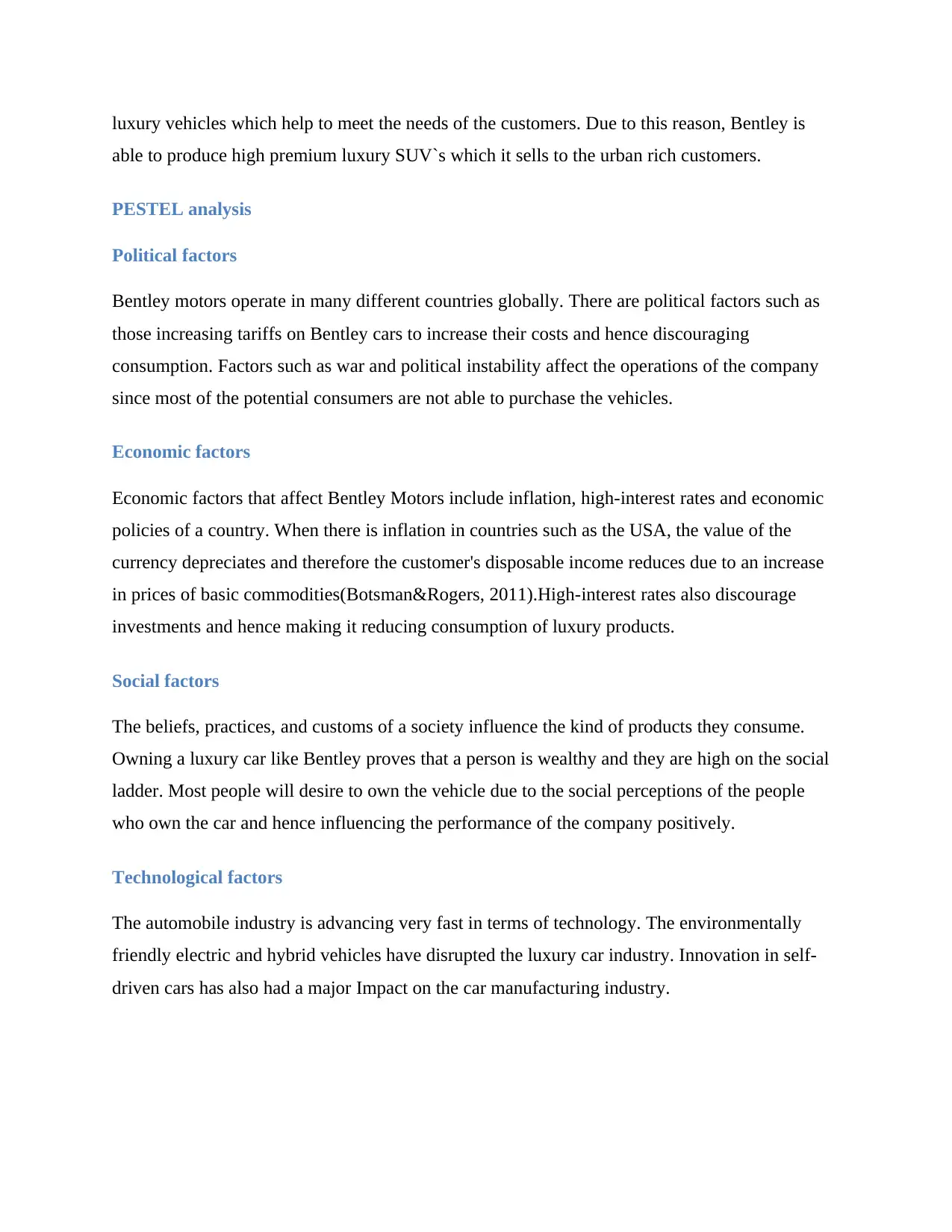
luxury vehicles which help to meet the needs of the customers. Due to this reason, Bentley is
able to produce high premium luxury SUV`s which it sells to the urban rich customers.
PESTEL analysis
Political factors
Bentley motors operate in many different countries globally. There are political factors such as
those increasing tariffs on Bentley cars to increase their costs and hence discouraging
consumption. Factors such as war and political instability affect the operations of the company
since most of the potential consumers are not able to purchase the vehicles.
Economic factors
Economic factors that affect Bentley Motors include inflation, high-interest rates and economic
policies of a country. When there is inflation in countries such as the USA, the value of the
currency depreciates and therefore the customer's disposable income reduces due to an increase
in prices of basic commodities(Botsman&Rogers, 2011).High-interest rates also discourage
investments and hence making it reducing consumption of luxury products.
Social factors
The beliefs, practices, and customs of a society influence the kind of products they consume.
Owning a luxury car like Bentley proves that a person is wealthy and they are high on the social
ladder. Most people will desire to own the vehicle due to the social perceptions of the people
who own the car and hence influencing the performance of the company positively.
Technological factors
The automobile industry is advancing very fast in terms of technology. The environmentally
friendly electric and hybrid vehicles have disrupted the luxury car industry. Innovation in self-
driven cars has also had a major Impact on the car manufacturing industry.
able to produce high premium luxury SUV`s which it sells to the urban rich customers.
PESTEL analysis
Political factors
Bentley motors operate in many different countries globally. There are political factors such as
those increasing tariffs on Bentley cars to increase their costs and hence discouraging
consumption. Factors such as war and political instability affect the operations of the company
since most of the potential consumers are not able to purchase the vehicles.
Economic factors
Economic factors that affect Bentley Motors include inflation, high-interest rates and economic
policies of a country. When there is inflation in countries such as the USA, the value of the
currency depreciates and therefore the customer's disposable income reduces due to an increase
in prices of basic commodities(Botsman&Rogers, 2011).High-interest rates also discourage
investments and hence making it reducing consumption of luxury products.
Social factors
The beliefs, practices, and customs of a society influence the kind of products they consume.
Owning a luxury car like Bentley proves that a person is wealthy and they are high on the social
ladder. Most people will desire to own the vehicle due to the social perceptions of the people
who own the car and hence influencing the performance of the company positively.
Technological factors
The automobile industry is advancing very fast in terms of technology. The environmentally
friendly electric and hybrid vehicles have disrupted the luxury car industry. Innovation in self-
driven cars has also had a major Impact on the car manufacturing industry.
Paraphrase This Document
Need a fresh take? Get an instant paraphrase of this document with our AI Paraphraser
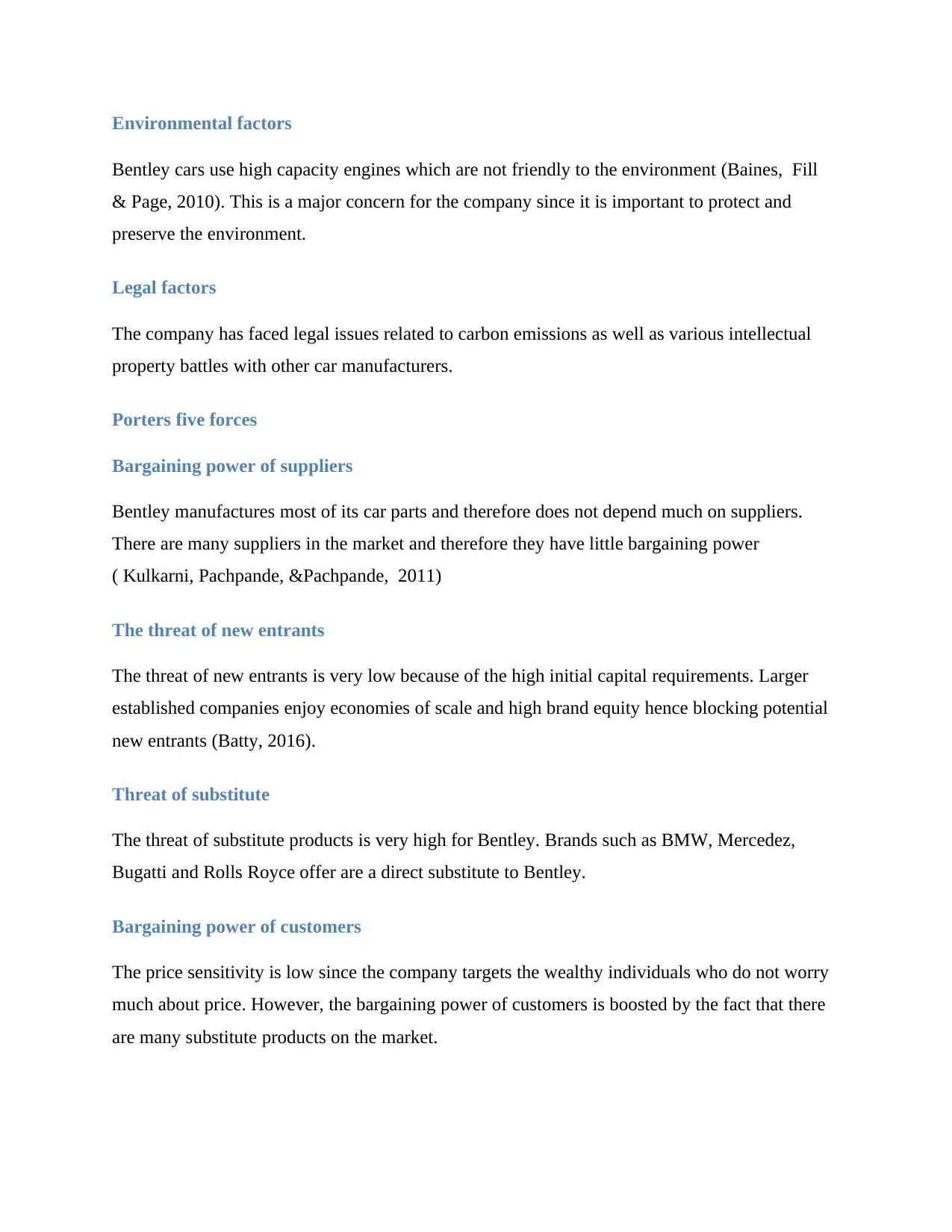
Environmental factors
Bentley cars use high capacity engines which are not friendly to the environment (Baines, Fill
& Page, 2010). This is a major concern for the company since it is important to protect and
preserve the environment.
Legal factors
The company has faced legal issues related to carbon emissions as well as various intellectual
property battles with other car manufacturers.
Porters five forces
Bargaining power of suppliers
Bentley manufactures most of its car parts and therefore does not depend much on suppliers.
There are many suppliers in the market and therefore they have little bargaining power
( Kulkarni, Pachpande, &Pachpande, 2011)
The threat of new entrants
The threat of new entrants is very low because of the high initial capital requirements. Larger
established companies enjoy economies of scale and high brand equity hence blocking potential
new entrants (Batty, 2016).
Threat of substitute
The threat of substitute products is very high for Bentley. Brands such as BMW, Mercedez,
Bugatti and Rolls Royce offer are a direct substitute to Bentley.
Bargaining power of customers
The price sensitivity is low since the company targets the wealthy individuals who do not worry
much about price. However, the bargaining power of customers is boosted by the fact that there
are many substitute products on the market.
Bentley cars use high capacity engines which are not friendly to the environment (Baines, Fill
& Page, 2010). This is a major concern for the company since it is important to protect and
preserve the environment.
Legal factors
The company has faced legal issues related to carbon emissions as well as various intellectual
property battles with other car manufacturers.
Porters five forces
Bargaining power of suppliers
Bentley manufactures most of its car parts and therefore does not depend much on suppliers.
There are many suppliers in the market and therefore they have little bargaining power
( Kulkarni, Pachpande, &Pachpande, 2011)
The threat of new entrants
The threat of new entrants is very low because of the high initial capital requirements. Larger
established companies enjoy economies of scale and high brand equity hence blocking potential
new entrants (Batty, 2016).
Threat of substitute
The threat of substitute products is very high for Bentley. Brands such as BMW, Mercedez,
Bugatti and Rolls Royce offer are a direct substitute to Bentley.
Bargaining power of customers
The price sensitivity is low since the company targets the wealthy individuals who do not worry
much about price. However, the bargaining power of customers is boosted by the fact that there
are many substitute products on the market.

Industry rivalry
There is a high level of innovation in the luxury car industry which increases the level of rivalry
among the firms operating in this industry. The firms in this industry also apply powerful
competitive strategy such as events sponsorship and hence heightening the level of industry
rivalry.
McKinley 7s
Strategy- Bentley has put in place strategies that have helped the company gain a competitive
advantage over its rivals in the market.
Structure- Bentley motors has a centralized organizational structure that where command runs
from up to down (Armstrong, Adam, Denize&Kotler, 2014). The structure ensures proper
coordination of activities between various departments within the organization.
Systems- the activities that take place at the company include engineering works to manufacture
new vehicles. Research and development activities are also a significant part of the companies`
systems.
Shared values-the shared values for the company include innovation and prioritization of the
customer. Honesty and integrity are also important values for the company (Marmol,
Feys&Probert, 2015).
Skills- the employees at the company need to be highly qualified in engineering field since the
industry is very technical.
Style- The company has adopted transformative leadership style which is guided by innovation
and desire to be the market leader in relation to innovation and new product development.
Staff- Bentley motors have the most talented individuals in the industry. The employees are
highly qualified and experienced. This explains the uniqueness of design and quality of the end
product.
There is a high level of innovation in the luxury car industry which increases the level of rivalry
among the firms operating in this industry. The firms in this industry also apply powerful
competitive strategy such as events sponsorship and hence heightening the level of industry
rivalry.
McKinley 7s
Strategy- Bentley has put in place strategies that have helped the company gain a competitive
advantage over its rivals in the market.
Structure- Bentley motors has a centralized organizational structure that where command runs
from up to down (Armstrong, Adam, Denize&Kotler, 2014). The structure ensures proper
coordination of activities between various departments within the organization.
Systems- the activities that take place at the company include engineering works to manufacture
new vehicles. Research and development activities are also a significant part of the companies`
systems.
Shared values-the shared values for the company include innovation and prioritization of the
customer. Honesty and integrity are also important values for the company (Marmol,
Feys&Probert, 2015).
Skills- the employees at the company need to be highly qualified in engineering field since the
industry is very technical.
Style- The company has adopted transformative leadership style which is guided by innovation
and desire to be the market leader in relation to innovation and new product development.
Staff- Bentley motors have the most talented individuals in the industry. The employees are
highly qualified and experienced. This explains the uniqueness of design and quality of the end
product.

Identifying strategic groups
The products offered by firms in this market are very diverse. All the companies in the luxury car
market differentiate products according to design, engine type as well as other technological
aspects. The extent of geographical coverage of Bentley is very limited since the company
operates only in developed countries. Distribution is from the manufacturer to the motor dealer
and the final consumer. The company does not engage in many marketing and advertisement
activities (Rao, Rao&Sivaramakrishna, 2008). It is highly vertically integrated since it supplies
most of the car parts. Products are of high quality and it is a technological leader in this market.
Section Two
Strengths
Brand Uniqueness- The brand of the Bentley vehicles is very popular since the company
manufactures cars that are unique according to customer specifications (Fich, 2009). Bentley
does not carry out promotional activities since it's a premium brand that is capable of selling
itself.
Popularity- Bentley cars are very popular globally because of their luxurious and sporty design.
Their endurance and quality also make the brand very popular among customers.
Research and development-the company has a vibrant team of professionals who research on the
technological development of the vehicles as well as design. This makes the brand compete
effectively in the global luxury car market.
Car design- Bentley manufactures some of the most beautiful cars on the planet. The
manufacturers design many different car models targeted at different customer segments and
therefore its ability to attract many luxury car enthusiasts (Kapferer, Bastien & Dawsonera.
2012) High brand value- Bentley has high brand equity which helps the company compete
effectively in the market. The Bentley brand has carved a niche in the automobile industry and
hence making it difficult for new competitors to enter the market.
The products offered by firms in this market are very diverse. All the companies in the luxury car
market differentiate products according to design, engine type as well as other technological
aspects. The extent of geographical coverage of Bentley is very limited since the company
operates only in developed countries. Distribution is from the manufacturer to the motor dealer
and the final consumer. The company does not engage in many marketing and advertisement
activities (Rao, Rao&Sivaramakrishna, 2008). It is highly vertically integrated since it supplies
most of the car parts. Products are of high quality and it is a technological leader in this market.
Section Two
Strengths
Brand Uniqueness- The brand of the Bentley vehicles is very popular since the company
manufactures cars that are unique according to customer specifications (Fich, 2009). Bentley
does not carry out promotional activities since it's a premium brand that is capable of selling
itself.
Popularity- Bentley cars are very popular globally because of their luxurious and sporty design.
Their endurance and quality also make the brand very popular among customers.
Research and development-the company has a vibrant team of professionals who research on the
technological development of the vehicles as well as design. This makes the brand compete
effectively in the global luxury car market.
Car design- Bentley manufactures some of the most beautiful cars on the planet. The
manufacturers design many different car models targeted at different customer segments and
therefore its ability to attract many luxury car enthusiasts (Kapferer, Bastien & Dawsonera.
2012) High brand value- Bentley has high brand equity which helps the company compete
effectively in the market. The Bentley brand has carved a niche in the automobile industry and
hence making it difficult for new competitors to enter the market.
Secure Best Marks with AI Grader
Need help grading? Try our AI Grader for instant feedback on your assignments.
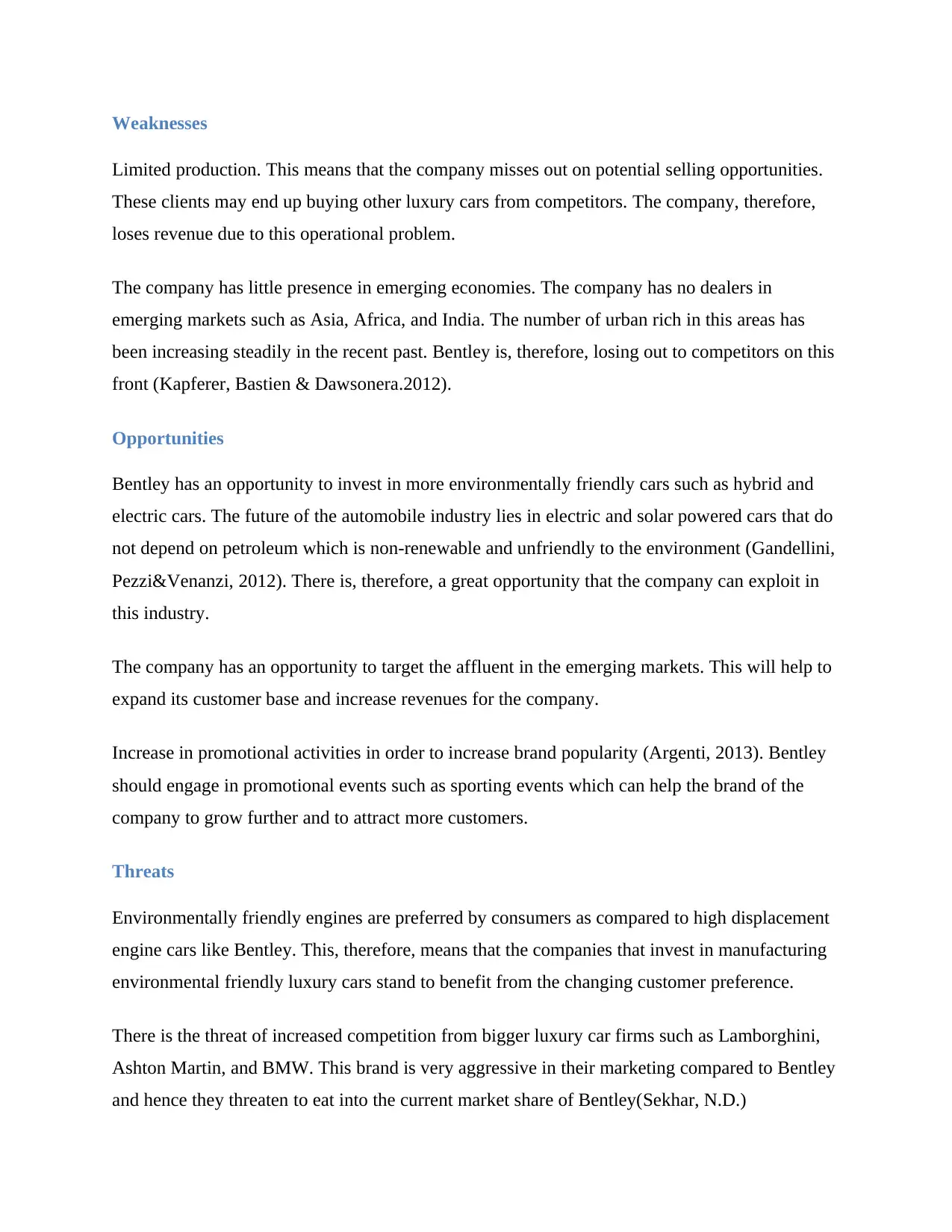
Weaknesses
Limited production. This means that the company misses out on potential selling opportunities.
These clients may end up buying other luxury cars from competitors. The company, therefore,
loses revenue due to this operational problem.
The company has little presence in emerging economies. The company has no dealers in
emerging markets such as Asia, Africa, and India. The number of urban rich in this areas has
been increasing steadily in the recent past. Bentley is, therefore, losing out to competitors on this
front (Kapferer, Bastien & Dawsonera.2012).
Opportunities
Bentley has an opportunity to invest in more environmentally friendly cars such as hybrid and
electric cars. The future of the automobile industry lies in electric and solar powered cars that do
not depend on petroleum which is non-renewable and unfriendly to the environment (Gandellini,
Pezzi&Venanzi, 2012). There is, therefore, a great opportunity that the company can exploit in
this industry.
The company has an opportunity to target the affluent in the emerging markets. This will help to
expand its customer base and increase revenues for the company.
Increase in promotional activities in order to increase brand popularity (Argenti, 2013). Bentley
should engage in promotional events such as sporting events which can help the brand of the
company to grow further and to attract more customers.
Threats
Environmentally friendly engines are preferred by consumers as compared to high displacement
engine cars like Bentley. This, therefore, means that the companies that invest in manufacturing
environmental friendly luxury cars stand to benefit from the changing customer preference.
There is the threat of increased competition from bigger luxury car firms such as Lamborghini,
Ashton Martin, and BMW. This brand is very aggressive in their marketing compared to Bentley
and hence they threaten to eat into the current market share of Bentley(Sekhar, N.D.)
Limited production. This means that the company misses out on potential selling opportunities.
These clients may end up buying other luxury cars from competitors. The company, therefore,
loses revenue due to this operational problem.
The company has little presence in emerging economies. The company has no dealers in
emerging markets such as Asia, Africa, and India. The number of urban rich in this areas has
been increasing steadily in the recent past. Bentley is, therefore, losing out to competitors on this
front (Kapferer, Bastien & Dawsonera.2012).
Opportunities
Bentley has an opportunity to invest in more environmentally friendly cars such as hybrid and
electric cars. The future of the automobile industry lies in electric and solar powered cars that do
not depend on petroleum which is non-renewable and unfriendly to the environment (Gandellini,
Pezzi&Venanzi, 2012). There is, therefore, a great opportunity that the company can exploit in
this industry.
The company has an opportunity to target the affluent in the emerging markets. This will help to
expand its customer base and increase revenues for the company.
Increase in promotional activities in order to increase brand popularity (Argenti, 2013). Bentley
should engage in promotional events such as sporting events which can help the brand of the
company to grow further and to attract more customers.
Threats
Environmentally friendly engines are preferred by consumers as compared to high displacement
engine cars like Bentley. This, therefore, means that the companies that invest in manufacturing
environmental friendly luxury cars stand to benefit from the changing customer preference.
There is the threat of increased competition from bigger luxury car firms such as Lamborghini,
Ashton Martin, and BMW. This brand is very aggressive in their marketing compared to Bentley
and hence they threaten to eat into the current market share of Bentley(Sekhar, N.D.)
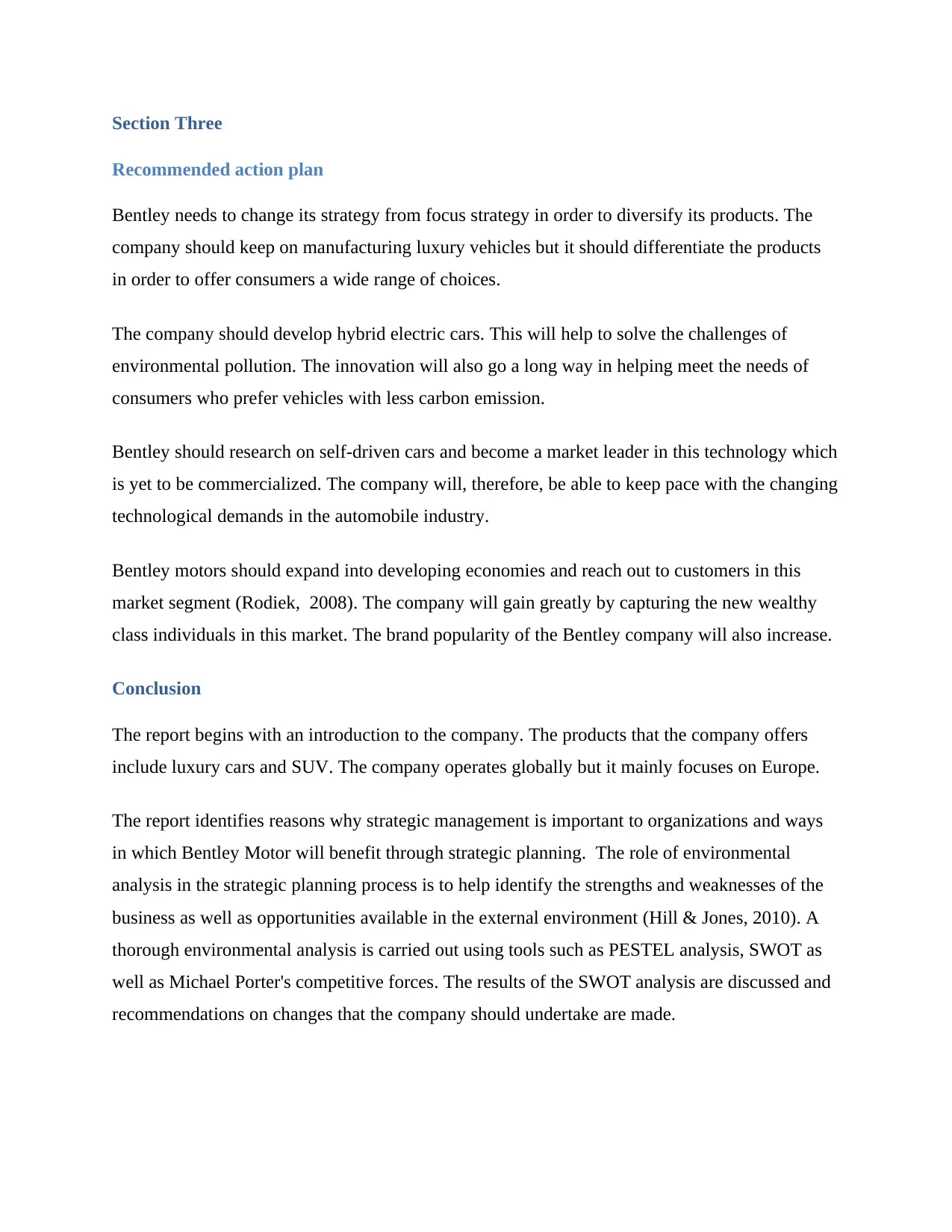
Section Three
Recommended action plan
Bentley needs to change its strategy from focus strategy in order to diversify its products. The
company should keep on manufacturing luxury vehicles but it should differentiate the products
in order to offer consumers a wide range of choices.
The company should develop hybrid electric cars. This will help to solve the challenges of
environmental pollution. The innovation will also go a long way in helping meet the needs of
consumers who prefer vehicles with less carbon emission.
Bentley should research on self-driven cars and become a market leader in this technology which
is yet to be commercialized. The company will, therefore, be able to keep pace with the changing
technological demands in the automobile industry.
Bentley motors should expand into developing economies and reach out to customers in this
market segment (Rodiek, 2008). The company will gain greatly by capturing the new wealthy
class individuals in this market. The brand popularity of the Bentley company will also increase.
Conclusion
The report begins with an introduction to the company. The products that the company offers
include luxury cars and SUV. The company operates globally but it mainly focuses on Europe.
The report identifies reasons why strategic management is important to organizations and ways
in which Bentley Motor will benefit through strategic planning. The role of environmental
analysis in the strategic planning process is to help identify the strengths and weaknesses of the
business as well as opportunities available in the external environment (Hill & Jones, 2010). A
thorough environmental analysis is carried out using tools such as PESTEL analysis, SWOT as
well as Michael Porter's competitive forces. The results of the SWOT analysis are discussed and
recommendations on changes that the company should undertake are made.
Recommended action plan
Bentley needs to change its strategy from focus strategy in order to diversify its products. The
company should keep on manufacturing luxury vehicles but it should differentiate the products
in order to offer consumers a wide range of choices.
The company should develop hybrid electric cars. This will help to solve the challenges of
environmental pollution. The innovation will also go a long way in helping meet the needs of
consumers who prefer vehicles with less carbon emission.
Bentley should research on self-driven cars and become a market leader in this technology which
is yet to be commercialized. The company will, therefore, be able to keep pace with the changing
technological demands in the automobile industry.
Bentley motors should expand into developing economies and reach out to customers in this
market segment (Rodiek, 2008). The company will gain greatly by capturing the new wealthy
class individuals in this market. The brand popularity of the Bentley company will also increase.
Conclusion
The report begins with an introduction to the company. The products that the company offers
include luxury cars and SUV. The company operates globally but it mainly focuses on Europe.
The report identifies reasons why strategic management is important to organizations and ways
in which Bentley Motor will benefit through strategic planning. The role of environmental
analysis in the strategic planning process is to help identify the strengths and weaknesses of the
business as well as opportunities available in the external environment (Hill & Jones, 2010). A
thorough environmental analysis is carried out using tools such as PESTEL analysis, SWOT as
well as Michael Porter's competitive forces. The results of the SWOT analysis are discussed and
recommendations on changes that the company should undertake are made.
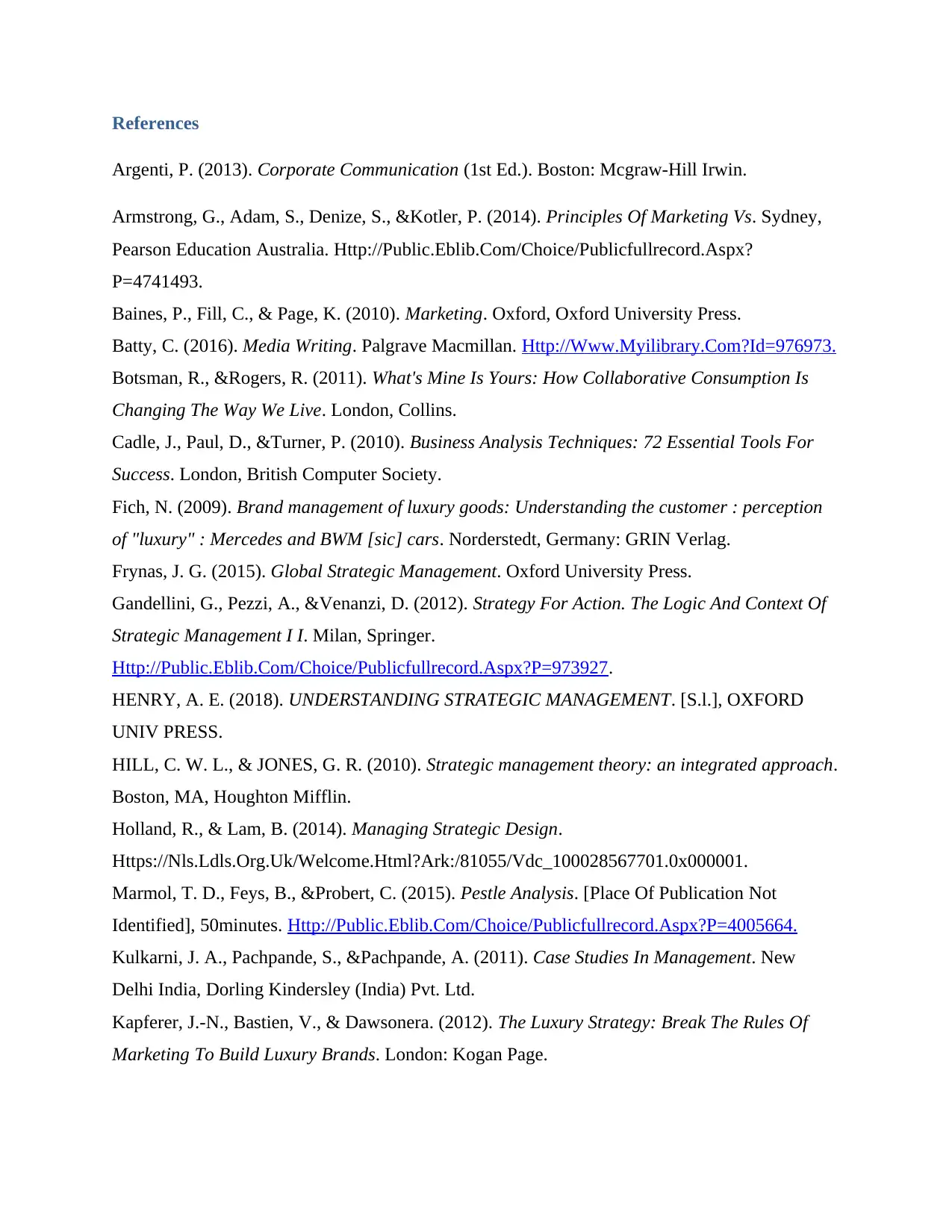
References
Argenti, P. (2013). Corporate Communication (1st Ed.). Boston: Mcgraw-Hill Irwin.
Armstrong, G., Adam, S., Denize, S., &Kotler, P. (2014). Principles Of Marketing Vs. Sydney,
Pearson Education Australia. Http://Public.Eblib.Com/Choice/Publicfullrecord.Aspx?
P=4741493.
Baines, P., Fill, C., & Page, K. (2010). Marketing. Oxford, Oxford University Press.
Batty, C. (2016). Media Writing. Palgrave Macmillan. Http://Www.Myilibrary.Com?Id=976973.
Botsman, R., &Rogers, R. (2011). What's Mine Is Yours: How Collaborative Consumption Is
Changing The Way We Live. London, Collins.
Cadle, J., Paul, D., &Turner, P. (2010). Business Analysis Techniques: 72 Essential Tools For
Success. London, British Computer Society.
Fich, N. (2009). Brand management of luxury goods: Understanding the customer : perception
of "luxury" : Mercedes and BWM [sic] cars. Norderstedt, Germany: GRIN Verlag.
Frynas, J. G. (2015). Global Strategic Management. Oxford University Press.
Gandellini, G., Pezzi, A., &Venanzi, D. (2012). Strategy For Action. The Logic And Context Of
Strategic Management I I. Milan, Springer.
Http://Public.Eblib.Com/Choice/Publicfullrecord.Aspx?P=973927.
HENRY, A. E. (2018). UNDERSTANDING STRATEGIC MANAGEMENT. [S.l.], OXFORD
UNIV PRESS.
HILL, C. W. L., & JONES, G. R. (2010). Strategic management theory: an integrated approach.
Boston, MA, Houghton Mifflin.
Holland, R., & Lam, B. (2014). Managing Strategic Design.
Https://Nls.Ldls.Org.Uk/Welcome.Html?Ark:/81055/Vdc_100028567701.0x000001.
Marmol, T. D., Feys, B., &Probert, C. (2015). Pestle Analysis. [Place Of Publication Not
Identified], 50minutes. Http://Public.Eblib.Com/Choice/Publicfullrecord.Aspx?P=4005664.
Kulkarni, J. A., Pachpande, S., &Pachpande, A. (2011). Case Studies In Management. New
Delhi India, Dorling Kindersley (India) Pvt. Ltd.
Kapferer, J.-N., Bastien, V., & Dawsonera. (2012). The Luxury Strategy: Break The Rules Of
Marketing To Build Luxury Brands. London: Kogan Page.
Argenti, P. (2013). Corporate Communication (1st Ed.). Boston: Mcgraw-Hill Irwin.
Armstrong, G., Adam, S., Denize, S., &Kotler, P. (2014). Principles Of Marketing Vs. Sydney,
Pearson Education Australia. Http://Public.Eblib.Com/Choice/Publicfullrecord.Aspx?
P=4741493.
Baines, P., Fill, C., & Page, K. (2010). Marketing. Oxford, Oxford University Press.
Batty, C. (2016). Media Writing. Palgrave Macmillan. Http://Www.Myilibrary.Com?Id=976973.
Botsman, R., &Rogers, R. (2011). What's Mine Is Yours: How Collaborative Consumption Is
Changing The Way We Live. London, Collins.
Cadle, J., Paul, D., &Turner, P. (2010). Business Analysis Techniques: 72 Essential Tools For
Success. London, British Computer Society.
Fich, N. (2009). Brand management of luxury goods: Understanding the customer : perception
of "luxury" : Mercedes and BWM [sic] cars. Norderstedt, Germany: GRIN Verlag.
Frynas, J. G. (2015). Global Strategic Management. Oxford University Press.
Gandellini, G., Pezzi, A., &Venanzi, D. (2012). Strategy For Action. The Logic And Context Of
Strategic Management I I. Milan, Springer.
Http://Public.Eblib.Com/Choice/Publicfullrecord.Aspx?P=973927.
HENRY, A. E. (2018). UNDERSTANDING STRATEGIC MANAGEMENT. [S.l.], OXFORD
UNIV PRESS.
HILL, C. W. L., & JONES, G. R. (2010). Strategic management theory: an integrated approach.
Boston, MA, Houghton Mifflin.
Holland, R., & Lam, B. (2014). Managing Strategic Design.
Https://Nls.Ldls.Org.Uk/Welcome.Html?Ark:/81055/Vdc_100028567701.0x000001.
Marmol, T. D., Feys, B., &Probert, C. (2015). Pestle Analysis. [Place Of Publication Not
Identified], 50minutes. Http://Public.Eblib.Com/Choice/Publicfullrecord.Aspx?P=4005664.
Kulkarni, J. A., Pachpande, S., &Pachpande, A. (2011). Case Studies In Management. New
Delhi India, Dorling Kindersley (India) Pvt. Ltd.
Kapferer, J.-N., Bastien, V., & Dawsonera. (2012). The Luxury Strategy: Break The Rules Of
Marketing To Build Luxury Brands. London: Kogan Page.
Paraphrase This Document
Need a fresh take? Get an instant paraphrase of this document with our AI Paraphraser

Kotler, P., &Pfoertsch, W. (2010). Ingredient Branding Making The Invisible Visible.
Heidelberg, Springer. Https://Www.Dawsonera.Com/Guard/Protected/Dawson.Jsp?
Name=Https://Netlogin.Strath.Ac.Uk/Shibboleth&Dest=Http://Www.Dawsonera.Com/Depp/
Reader/Protected/External/Abstractview/S9783642042140.
Rao, C. A., Rao, B. P., &Sivaramakrishna, K. (2008). Strategic Management And Business
Policy: Texts And Cases. New Delhi, India, Excel.
Rodiek, C. (2008). External Environmental Analysis - The U.S. Television Manufacturing
Industry. MüNchen, Grin VerlagGmbh. Http://Nbn-Resolving.De/Urn:Nbn:De:101:1-
201008255037.
Smith, B., &Raspin, P. (2013). Creating Market Insight: How Firms Create Value From Market
Understanding. Hoboken, N.J., Wiley. Http://Rbdigital.Oneclickdigital.Com.
Sekhar, G. V. S. (N.D.). Business Policy And Strategic Management. [S.L.], I K International
Public.
Heidelberg, Springer. Https://Www.Dawsonera.Com/Guard/Protected/Dawson.Jsp?
Name=Https://Netlogin.Strath.Ac.Uk/Shibboleth&Dest=Http://Www.Dawsonera.Com/Depp/
Reader/Protected/External/Abstractview/S9783642042140.
Rao, C. A., Rao, B. P., &Sivaramakrishna, K. (2008). Strategic Management And Business
Policy: Texts And Cases. New Delhi, India, Excel.
Rodiek, C. (2008). External Environmental Analysis - The U.S. Television Manufacturing
Industry. MüNchen, Grin VerlagGmbh. Http://Nbn-Resolving.De/Urn:Nbn:De:101:1-
201008255037.
Smith, B., &Raspin, P. (2013). Creating Market Insight: How Firms Create Value From Market
Understanding. Hoboken, N.J., Wiley. Http://Rbdigital.Oneclickdigital.Com.
Sekhar, G. V. S. (N.D.). Business Policy And Strategic Management. [S.L.], I K International
Public.
1 out of 14
Related Documents
Your All-in-One AI-Powered Toolkit for Academic Success.
+13062052269
info@desklib.com
Available 24*7 on WhatsApp / Email
![[object Object]](/_next/static/media/star-bottom.7253800d.svg)
Unlock your academic potential
© 2024 | Zucol Services PVT LTD | All rights reserved.





